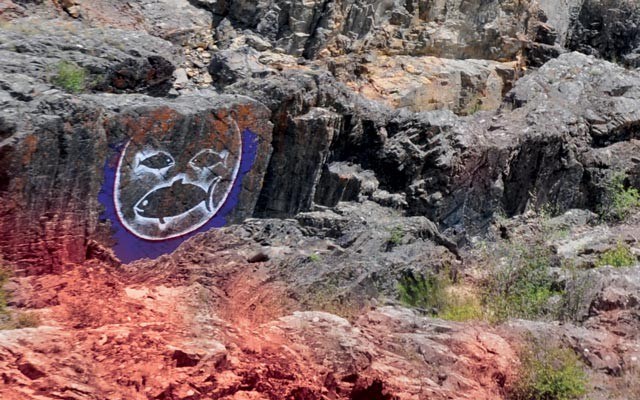Millennia before a flood of gold miners 50,000 strong swept through Lillooet in the 1850s — and in the process changed life in the Sea to Sky corridor forever — there was one big reason a large settlement of native peoples lived where the Bridge River meets the mighty Fraser. St'át'imc tour guide Josh Jack knows why: "Salmon, salmon, salmon."
The fourth-year Emily Carr University of Art and Design student, who works summers at Lillooet-based Xwísten Experience Tours, was standing beside an archeological dig just upriver from where the blue-green waters of the Bridge and Big Muddy merge in the sun-baked, sagebrush-covered depths of the Fraser Canyon. "At the height of the settlement there were 80 to 95 pit houses here," he told Pique, "of which three-quarters would have been occupied at any one time. The size speaks to the bountifulness of the Bridge River Valley."
Repeated excavations led by University of Montana archeologist Dr. Anna Marie Prentiss have slowly unearthed the remains of a village where Jack said his people first settled 3,000-to-4,000 years ago. "Before that, based on carbon dating of a carved soapstone female figure and a male figure carved from bone, nomadic tribes visited here as early as 6,000 B.C." Chances are good that whether then or now, people converged here in August when sockeye salmon began their upstream migration. That's the central theme of the traditional fishing rock and archeological village outings conducted daily from June through September.
Pique's visit began with a welcome from Josh Jack to the traditional St'át'imc (pronounced Stat-lee-um) territory. The Xwísten, or "smiley face people," of Bridge River are one of 11 allied communities spread between the head of Harrison Lake to the south and Pavilion near Highway 99's northern terminus at Hat Creek. In all, eight First Nations bands gather in Lillooet to fish, each with a hereditary space on rock outcroppings that dot both east and west sides of the canyon, one of the last places on the Fraser River where fishing is still carried on in the traditional way with dip nets.
In 1978, in a defiant gesture to the government of the day to protest proposed restrictions on aboriginal fishing rights, Xwísten (also spelt Nxwísten) chief Saul Terry painted a smiley face on a rock at the confluence of the two rivers that has stood the test of time. As part of the tour, Jack leads visitors along a well-worn trail down onto an outcropping on which the painted boulder sits. Up close, it's easy to discern the shapes of two small salmon and one much larger fish, grouped together in such a way as to give the appearance of two eyes and a mouth.
At the tour kiosk, Jack, whose traditional name is ShQeqtsega, or "older brother," asked everyone to gather round for a demonstration on how sockeye salmon is prepared for drying. "Watch how I draw the knife as close as possible to the backbone," he described as he made a deft incision. "Hear how my knife makes a clicking sound like a grasshopper? Our elders' wisdom says when grasshoppers begin to make the clicking sound, it's time to begin fishing and not before." Laid out on the cutting board are knives of three different sharpness. "I use the sharpest one to remove the head and fins and the medium-to-dull ones to cut up the fish for drying without cutting through the skin." Slowly, with a sureness that implied he'd done this so often the moves almost came automatically, Jack splayed out the salmon, ready now to be hung on the drying racks that stand like tent frames beside the river, constructed to take full advantage of the arid winds drawn through the canyon by the motion of the river and updrafts from the heat of the day. When asked the length of time needed to finish the process, Jack said it takes four days in Lillooet but almost twice that for sockeye caught downstream in the Fraser Valley. "Those fish have more fat on them and the air is much moister. I prefer our style. It tastes richer."
As Pique's visit occurred before the sockeye had begun their annual run, the one Jack fileted came from the freezer. "Once our family puts aside enough to feed all 15 of us, I catch sockeye at the end of the season and freeze them for next year's tours as well as for customers who just drop in for barbecue bannock burgers at the kiosk and take in the view." Perched a short way above the fishing rocks, well-worn trails lead from the food stand with its outdoor tables to the banks of the Bridge and from there to the Fraser. Given the dire predictions as to the size of this year's sockeye runs, if you can't make it up the Duffey Lake Road to Lillooet to see for yourself — perhaps sweetened by a tour of the nearby Fort Berens Estate Winery — at least send a "salmon, salmon, salmon" prayer the smiley-faced people's way.
Access: Lillooet lies 144 kilometres northeast of Whistler on Highway 99. For information on Xwísten Experience Tours, visit www.xwistentours.ca. For information on Fort Berens Estate Winery, visit www.fortberens.ca
Pique contributor Jack Christie is the author of The Whistler Book (Greystone). For more information, visit www.jackchristie.com




